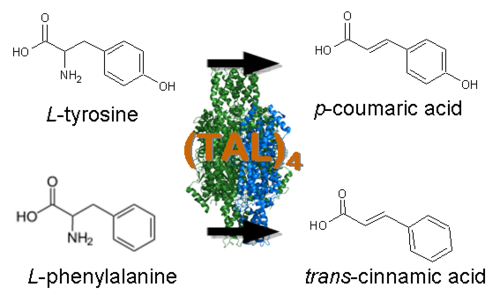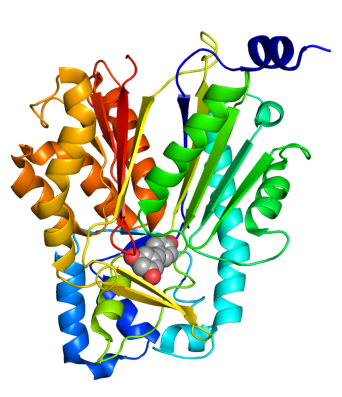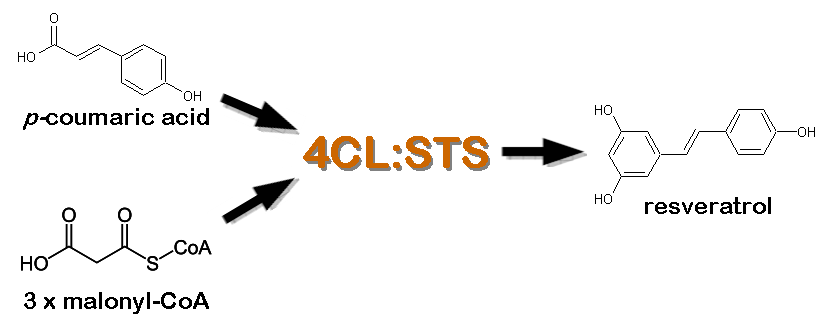Team:Rice University/STRATEGY
From 2008.igem.org
(Difference between revisions)
StevensonT (Talk | contribs) (Undo revision 97365 by StevensonT (Talk)) |
StevensonT (Talk | contribs) |
||
| Line 26: | Line 26: | ||
[[Image:STS.png|right|190px|thumb|[http://www.rcsb.org/pdb/explore.do?structureId=1Z1F Peanut STS] monomer bound to resveratrol.]] | [[Image:STS.png|right|190px|thumb|[http://www.rcsb.org/pdb/explore.do?structureId=1Z1F Peanut STS] monomer bound to resveratrol.]] | ||
*[http://www.ncbi.nlm.nih.gov/entrez/viewer.fcgi?val=NM_001084228.1 4-coumarate CoA ligase] :: [http://www.ncbi.nlm.nih.gov/entrez/viewer.fcgi?tool=portal&db=nuccore&term=&query_key=18&dopt=gb&dispmax=20&page=1&qty=1&WebEnv=1BAyWdNufvUWxpNM-oKD-9JoRgEPTXzU_kF02A2hfcePWB3nxyPvHO3gqlDJksRdZq9GmTDHNDmKEFuabzP4VKB%40263F5D1B8F754EA0_0062SID&WebEnvRq=1 Stilbene Synthase] Fusion Protein (aka 4CL:STS, [http://partsregistry.org/wiki/index.php?title=Part:BBa_K122005 BBa_K122005]) - This enzyme fusion is comprised of ''Arabidopsis thaliana'' 4-coumarate-CoA ligase (4CL), which catalyzes the conversion of ''p''-coumaric acid to 4-coumaroyl-CoA, and ''Vitis vinifera'' Stilbene Synthase, which catalyzes the condensation of resveratrol from 4-coumaroyl-CoA and three malonyl-CoA molecules. This 4CL:STS fusion protein was selected for our project because it has been shown to more efficiently produce resveratrol than coexpression of the proteins separately (possibly due to substrate channeling). | *[http://www.ncbi.nlm.nih.gov/entrez/viewer.fcgi?val=NM_001084228.1 4-coumarate CoA ligase] :: [http://www.ncbi.nlm.nih.gov/entrez/viewer.fcgi?tool=portal&db=nuccore&term=&query_key=18&dopt=gb&dispmax=20&page=1&qty=1&WebEnv=1BAyWdNufvUWxpNM-oKD-9JoRgEPTXzU_kF02A2hfcePWB3nxyPvHO3gqlDJksRdZq9GmTDHNDmKEFuabzP4VKB%40263F5D1B8F754EA0_0062SID&WebEnvRq=1 Stilbene Synthase] Fusion Protein (aka 4CL:STS, [http://partsregistry.org/wiki/index.php?title=Part:BBa_K122005 BBa_K122005]) - This enzyme fusion is comprised of ''Arabidopsis thaliana'' 4-coumarate-CoA ligase (4CL), which catalyzes the conversion of ''p''-coumaric acid to 4-coumaroyl-CoA, and ''Vitis vinifera'' Stilbene Synthase, which catalyzes the condensation of resveratrol from 4-coumaroyl-CoA and three malonyl-CoA molecules. This 4CL:STS fusion protein was selected for our project because it has been shown to more efficiently produce resveratrol than coexpression of the proteins separately (possibly due to substrate channeling). | ||
| - | [[Image:4CL_STS catalysis.png|left| | + | [[Image:4CL_STS catalysis.png|left|600px]] |
<BR><BR><BR><BR><BR><BR><BR><BR><BR><BR><BR> | <BR><BR><BR><BR><BR><BR><BR><BR><BR><BR><BR> | ||
Revision as of 23:04, 29 October 2008
| OUR TEAM ::: SUMMARY ::: INTRODUCTION ::: STRATEGY ::: RESULTS ::: ONGOING WORK ::: GALLERY
SUMMARY ::: BACKGROUND ::: STRATEGY ::: CONSTRUCTS ::: RESULTS ::: ONGOING WORK ::: OUR TEAM ::: NOTEBOOK ::: GALLERY |
 "
"






